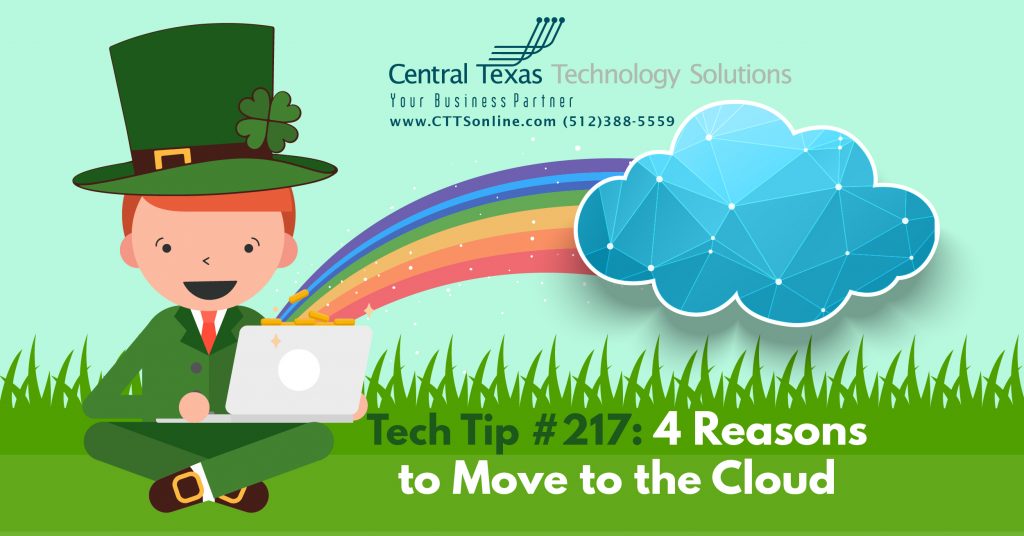 Cloud computing has been a buzzword in modern business and information technology (IT) for a decade now. During that time, we have seen major changes and improvement to Cloud services. Major providers like Microsoft, Amazon, Google and others provide all manner of services. These include software licensing to Cloud based software services to full blown Cloud servers and networking. This has caused a paradigm shift in modern business computing and how we do what we do. There are several reasons why businesses that have not moved to the Cloud should seriously consider it.
Cloud computing has been a buzzword in modern business and information technology (IT) for a decade now. During that time, we have seen major changes and improvement to Cloud services. Major providers like Microsoft, Amazon, Google and others provide all manner of services. These include software licensing to Cloud based software services to full blown Cloud servers and networking. This has caused a paradigm shift in modern business computing and how we do what we do. There are several reasons why businesses that have not moved to the Cloud should seriously consider it.
- Flexibility and Mobility - The days of traditional business within the four walls of an office are rapidly coming to an end. Workforces are becoming more mobile and distributed. Work from home is becoming more common and many of the younger generation entering the work force are looking for this flexibility. The consumerization of Information Technology has also had a huge impact. It is commonplace to see employees using personal phones, tablets and computing devices to do their work. Companies have had to embrace security strategies to account for this. The traditional security of firewall and antivirus is no longer sufficient as so many devices now exist outside the network. Security is shifting to securing devices and data. Mobile Device Management (MDM) and Bring Your Own Device (BYOD) policies are becoming the norm in even small business environments. Even some industries, like manufacturing, that reply upon on-premise systems and work still have some business functions and staff that can be mobile. On-premise systems are hybridized with Cloud systems to support mobility and have the best of both worlds in a consistent integrated environment.
- Operational vs Capital Expense - Traditional hardware refresh cycles have been every 3 to 6 years, depending on the type of equipment and warranty service involved. Usually, these revolved around major line of business or Operating system upgrades as newer hardware was required to support them. These are large outlays of capital expense, even if upgrade projects are phased over time. Businesses had to budget for this and ensure sufficient money was available or look to lease options. Some business types struggle with this, especially ones that are cash flow dependent. With moving to the Cloud, the business is no longer responsible for the infrastructure. The servers, networks and backup systems are the responsibility of the Cloud provider. Computing becomes commoditized and subscription based. This moves much of IT cost from Capital Expense (CAPEX) to Operational Expense (OPEX). This makes technology easier to budget for because it becomes more of a consistent monthly expense rather than large capital expense. The business only needs to worry about its local office network and Internet and the computers used to connect to the Cloud. This saves money and simplifies upgrade cycles.
- Reliability and Economies of Scale - Modern Cloud providers have massive data facilities that have multiple Internet connections, sit on multiple power grids and have large server farms with redundancy and failover. They are designed for uptime, all the time. They are also distributed between multiple datacenters, so a natural disaster won’t keep clients form accessing systems and data. This type of infrastructure costs millions of dollars to create and operate and is far beyond the capability of most business. It is far more reliable and secure than the infrastructure that most companies can afford. Fortunately, these providers can aggregate this cost across their client base and make it affordable for even small business to take advantage of these services. Cloud servers, virtual networks and virtual desktops can allow companies to place their entire infrastructure in the Cloud. This affords enormous flexibility as employees can access these systems from anywhere there is an Internet connection. These environments can also be dynamic. More virtual servers and desktops can be spun up to increase service during peak business hours when the load is high and shutdown when demand drops off to conserve costs.
- Futurizing Your Business - Cloud computing is the future. The Internet has transformed over the last 3 decades from a medium of static webpages to a dynamic, evolving marketplace of software and services. Indeed, there are now companies that completely exist online, their entire product portfolio consists of digital goods. Many software developers are moving from producing client/server software for local installation to software-as-a-service that streams or is accessed online. Entire corporate computing infrastructures live online. The consumerization of information technology is changing the way we provision and safeguard corporate data and applications. In fact, a day will come when most companies no longer issue corporate computing devices and just issue their employees virtual desktops that they can connect to with their own computers. Where some companies have job requirements of reliable transportation so their employees can do their jobs, companies will start requiring reliable computing devices and Internet connectivity so employees can access their virtual desktops and do their work.
Making the transition to the Cloud puts you ahead of the game and allows your business to be more flexible and resilient to changes in the market and business process. If you have not considered how this can benefit your business, contact CTTS today and we can help you make the transition and reap the benefits of the Cloud: (512) 388-5559.

By Kurt Rinear
Director of Technical Services
Central Texas Technology Solutions
